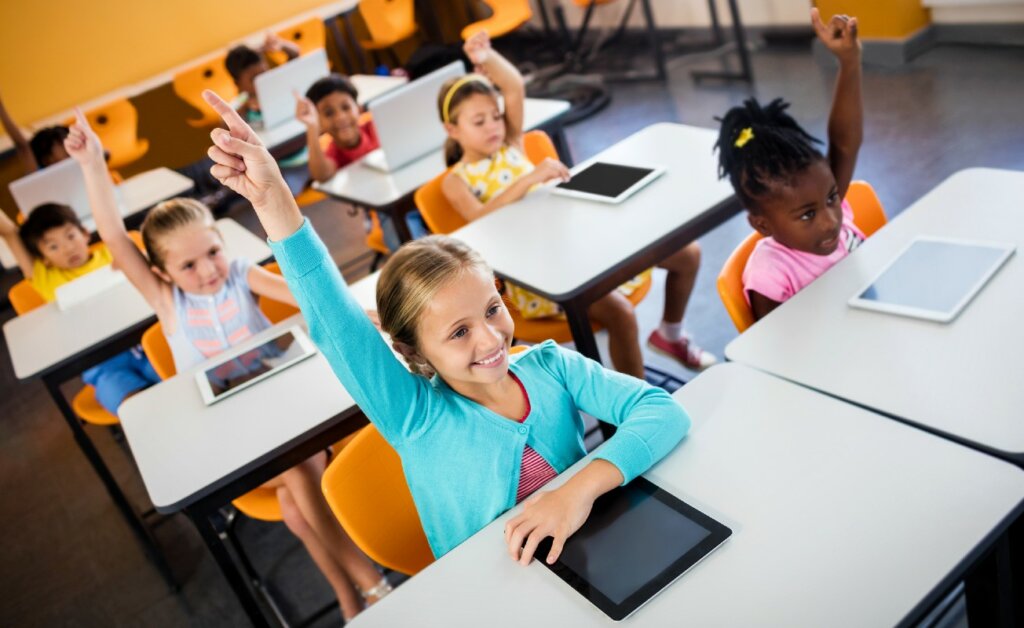For more than half a decade, the BlinkLearning learning platform has been conducting its Survey on the Use of Technology in Education. We wanted to review different reports, with their highlights and conclusions. These are our findings.
What is the Survey on the Use of Technology in Education?
In 2015, the BlinkLearning learning solution launched its first Study on the use of education technologies, with a specific goal in mind: to get to know the teaching community’s opinion on ICTs in classrooms, and to identify potential improvements on the current technologies applied on education.
Since the integration of technology in education was transforming the way students and teachers approach the learning process, we decided to analyse the use of ICTs in the classroom. In the words of Gonzalo Baranda, CEO of BlinkLearning, “We are convinced that technology has no value if there is not a teacher making good use of it”.
The report evolved in terms of the number of participating countries, sample size, questions on the form, and also in terms of data and conclusions. The role of technology, the teaching profession, student learning and an overview of the overall state of education from the teachers’ point of view are some the topics covered by the study.
We are convinced that technology has no value if there is not a teacher making good use of it”
Gonzalo Baranda, CEO of BlinkLearning
6th Global Survey on the use of technology in education (2021)
Launched in August 2021, the latest survey conducted by BlinkLearning has several new features. In the first place, a chapter dedicated to education in times of pandemic is added and allows us to analyze in more detail the use of technology during lockdown, what challenges it involved and its advantages. It also allows contrasting the data from the 5th Survey, prior to the pandemic.
Carried out among 4,926 teachers (2,909 from Latin America and 2,017 from Spain) instructing all educational levels, the sixth edition of this study offers a wide range of indicators to help understand how digital tools have been integrated into education in 2021. It also helps answer questions such as: How were digital tools integrated into education during the pandemic? How much was the teaching profession affected? How did Latin American and Spanish teachers perform during this new school year?
In addition, this edition introduces a Global Survey that contrasts data from Spain and 20 Latin American countries (Argentina, Bolivia, Brazil, Chile, Colombia, Costa Rica, Ecuador, El Salvador, Guatemala, Honduras, Mexico, Nicaragua, Panama, Paraguay, Peru, Puerto Rico, Dominican Republic, Uruguay and Venezuela).
Access the 6th Global Survey
Some tips for post-pandemic education
- Most teachers believe that the use of ICT has improved students’ motivation, after they were forced to use technology without adequate training.
- Globally, two out of three teachers feel that their profession has been more valued by society after the pandemic.
- Teachers are calling for improvements in connectivity, infrastructure and training.
- For teachers, the main challenge to improve education is to encourage autonomous learning in students, and they say that the use of technology during the pandemic has provided a solution.
- One out of three teachers believe that the main advantage of using technology during the pandemic has been to create community between students and teachers, bridging isolation and bringing them closer together.
- Despite structural difficulties, teachers continue to believe in the transformative potential of technology.
Learn more about the findings of the 6th Global Survey
5th Survey on the Use of Technology in Education (2019/2020)
In the fifth consecutive year of this study, the sample size and the number of participating countries increased. This edition, Argentina joins Spain, Mexico, Colombia and Peru, with a total of 3,268 teachers participating in the study. This includes all types of centres and educational stages. Apart from including comparative data among the five countries, conclusions now show comparisons with previous years.
In addition, this year, our report was disseminated as educational centres were being closed, in an effort to stop the spread of Coronavirus. This forced schools, institutes, training centers and universities to adopt remote learning. In that context, the V Study works as an X-ray showing in what stage of digitisation educational centres were at the time of switching to online classes in those countries surveyed.
How ready were schools and teachers to make this digital transformation leap in just a few days?
- The mobile phone is the unquestionable protagonist in classrooms, being the device most used by the students. Colombia is the country with the highest use of mobile phones (66%), followed by Argentina (61%), Mexico (49%), Peru (44%) and Spain (29%).
- The five countries share the same main challenges when it comes to introducing technology into classrooms. They all agree on teacher training and connectivity issues. The lack of sufficient devices is another recurring issue.
- For Argentina, Mexico and Peru, teacher training is the main educational challenge at a general level. For Colombia, it is improving teachers’ working conditions that is most pressing; on the other hand, in Spain, it is most important to achieve greater student motivation.
- About 90% of Spanish and Latin American teachers think that their profession is not sufficiently valued by society.
- The educational community of those five countries agree that the best approach to improve new teachers’ training is through more courses and specialisations.
- Most teachers in the countries surveyed said they would recommend a colleague to start a digital project in their learning centre.
4th Survey on the Use of Technology in Education (2018)
In its fourth edition, participation in the Study was extended to a total of five countries: Chile, Peru, Colombia, Mexico and Spain. This report is notable for including comparative data among the five countries.
With almost 6000 respondents, the main goal of this research was to find out what teachers think about the state of education, with emphasis on integrating new technologies into classrooms.
Some of the main conclusions of the 4th Survey are the following:
- In Latin America, more than 60% of teachers surveyed believe that connectivity is the main challenge when it comes to introducing ICTs in classrooms. For Spanish teachers, the biggest challenge is teacher training.
- More than 40% of participants believe the greatest difficulty for students is the inability to find reliable sources of information.
- About 90% of teachers think that their profession is not sufficiently valued in society.
- 76% of participants say that the main advantage of using technology in classrooms is the ability to access more content and resources. 66% consider that technology is, broadly speaking, a benefit for autonomous learning.
3rd Survey on the Use of Technology in Classrooms (2017)
On our third Survey, the sample size increased considerably, with more than 2,000 participants. In addition, Latin American countries’ key contribution represented 42 per cent of the sample.
Specifically, this edition included 2,078 teachers from Spain and Latin America, who answered an online questionnaire including 36 questions.
During May 2017, the debate on education had intensified. Thus, in this study, teachers were asked their opinions on issues that go beyond the purely technological: the status of the teaching profession, whether homework is necessary or not, or the major challenges facing education at the general level.
3rd Survey on the Use of Technology in Classrooms – Conclusions:
- For the third year in a row, teachers are in favour of including ICTs into classrooms, but they stress that this must come with better training for students and teachers. In this regard, 85 per cent of participants indicated that it is necessary to include subjects that improve students’ digital skills.
- 81.6% say that the relationship between the use of technology and student motivation is high or very high, with creativity, autonomy and connection to their digital habits being the factors that best explain this relationship.
- The possibility of accessing a greater volume of content and resources (76.9%) and the increase in motivation (73.4%) stand out as the main advantages for students using ICTs in classrooms.
- 49.5% considered homework to be necessary. In addition, 45.7% said that it would be ideal to personalise homework, but the pace of school life is not compatible with that.
2nd Survey on ICT Use in Classrooms (2016)
In this second edition, the novelty was the addition of the educational community of Latin America. 740 teachers from Spain and Latin America participated in the study. This meant a large number of students from public, private and/or subsidised schools, ranging from pre-school to university. In addition, the Study was carried out in collaboration with Universidad Rey Juan Carlos and Educación 3.0 and Enter.co magazines.
Some findings from the 2nd Survey:
- The main challenges of using technology in classrooms are: lack of teacher training in the use of ICTs (63.6%) and educational centres’ Internet connectivity (61.5%).
- 93% of teachers recommend starting a digital project. Furthermore, for most teachers, new technologies could help to address education deficits.
- 79% of teachers use new teaching methodologies, like Collaborative Learning and Project-based Learning, which are listed as the most popular.
1st Survey on ICT Use in Classrooms (2015)
It was carried out in June 2015, containing 15 questions, with a sample size of 355 teachers of Primary, Secondary and University educational level throughout Spain.
The 1st Survey revealed, among other things, that:
- Using technology increases student motivation (90% of respondents).
- Teacher training (68%) and connectivity (66%) are the main challenges for implementing a digital project.
- 81% of teachers surveyed mentioned that creation of own content is one of the main advantages offered by the use of technology.
- Digital blackboards and tablets are the most common devices in classrooms.
All the Survey on the Use of Technology in Education have been possible thanks to our entire team of advisors who have helped us disseminate the questionnaire, including the most relevant topics for the current teaching community.
Access the last reports:
6th Global Survey on the Use of Technology in Education
5th Survey on the Use of Technology in Education – Spain
4th Survey on the Use of Technology in Education – Spain
For more information about BlinkLearning’s Survey on the Use of Technology in Education:
Esther Antón
Communication and Marketing Manager
T +34 91 725 61 28
esther.anton@blinklearning.com


